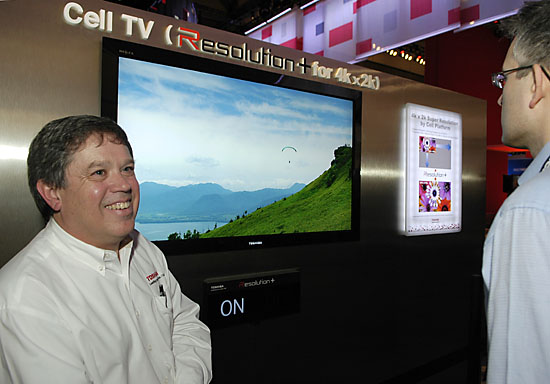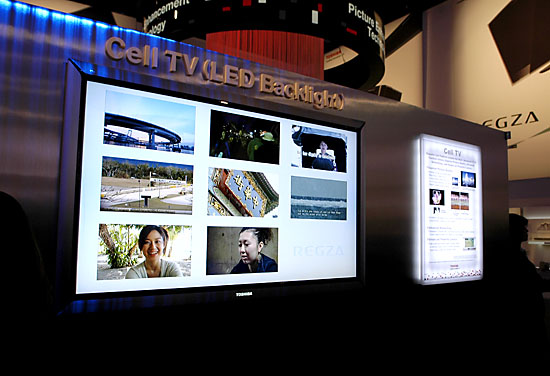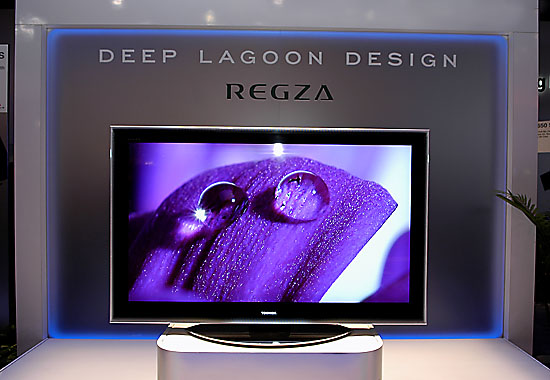CES 2009 - TV Trends, WirelessHD, 240Hz and Netbook Pricing
by Anand Lal Shimpi & Manveer Wasson on January 12, 2009 12:00 AM EST- Posted in
- Trade Shows
Toshiba Talks the Future of TVs
Toshiba was big on talking about the future of its LCD TVs at this year’s CES so we got a big tech demo of what’s to come.

Tosh was the only manufacturer to say that 4K x 2K panels will be the future of LCD TVs, the rest were far more focused on today’s 1080p displays. The name is a bit misleading as the actual panel resolution is 3840 x 2160 (or 2 * 1920 x 2 * 1080). Since it’s an even multiple of 1080p, upscaling 1080p content to a 4K panel isn’t difficult - so existing content should adapt well to it. While 4K displays are still a while away, as soon as there’s content to support it, we’ll start seeing them.

The 4K demo was done on Toshiba’s Cell powered TV. The Cell TV is powered by the same Cell processor that’s in Sony’s PlayStation 3, the difference being that here its used to drive the menu system and handles all upscaling of lower resolution content to the 4K panel. Additionally, the Cell processor runs the backlight dimming algorithm. The advantage here being that Cell is powerful enough to control more dimming zones than the Regza lineup’s current processor.

The Cell processor is also fast enough to decode 6 simultaneous HD streams at once. While you probably won’t watch six things at the same time, you could have a ridiculous picture in picture mode that’s very Back to the Future II-esque.
The rest of the technologies Toshiba talked about will be shipping on their 2009 model year Regza lineup.
Deep Lagoon is the name for Toshiba’s new bezel design. The idea is to make the panel and bezel seem as one. The bezel is black like the panel (but a more panel-like black) and is perforated as you get away from the panel to give it the appearance of fading away. The highest end Regza will have a bezel that is flush with the LCD panel.


Toshiba’s TVs will also include a technology called Dolby Volume. A modern take on a solution to an old problem: how to deal with watching content with different volumes. You know the case, you’re watching a TV show at a particular volume and are interrupted by a commercial that’s far too loud.
TVs have shipped with adaptive volume for quite some time, but Toshiba argues that the old solution wasn’t good. The old solution used to be to simply apply a low pass filter that would eliminate high frequency audio. You’d get the impression of lower volumes but at the expense of actually losing some of the audio.
Dolby Volume keeps all of the audio; it simply compresses the spectrum. Louder sounds get quieter and quieter sounds get louder, allowing you to listen at low to normal volumes without worrying about blowing out your ears if an inconsiderate commercial airs.
As is the case with all spectrum-compressing technologies, audio purists may want to opt out. Most of these sorts of technologies in TVs (including overboosting colors) tend to appeal to the users who aren’t as in tune with (or don’t care about) what things are intended to look/sound like. It’s the same reason that distorting 16:9 stretch modes are so popular despite what they do to peoples’ faces. Dolby Volume appears to be a better solution to the volume problem, but unless you dynamically adjust the volume on your TV set, compressing the spectrum isn’t going to be the most acoustically pure solution.
Toshiba is including an Expert Mode on its 2009 LCD TVs. Although we didn’t get any additional information, it sounded like an easily accessible service menu, giving end users the same access that a calibrator would have without the risk associated with modifying settings in the service menu. We’d hope that more TV manufacturers would expose service-menu settings in a safer environment for the enthusiast market.
Toshiba talked about a feature called Instaport. When you turn the TV on it will perform the HDCP handshaking with all HDMI devices that are connected and turned on, so that switching between the HDMI inputs on the TV is faster. Toshiba didn’t demo the technology and it’s only useful if you have a bunch of devices turned on all the time, but it’s an attempt at addressing an annoying problem with current TVs.
Another Toshiba-only tech topic was 14-bit color processing on its Regza TVs. The LCD themselves don’t use 14-bit panels, but all processing is done internally with 14-bit resolution and then downsampled upon output. There are situations where 14-bit internal precision could help reduce color banding but I’m guessing that more often than not you won’t notice a difference.










30 Comments
View All Comments
araczynski - Monday, January 12, 2009 - link
I guess its a good thing then that I don't watch enough TV/Movies to care about these new tv developments. My two 2 year old LCD's will just have to 'do' until they die.the only netbook i've ever liked is that acer aspire one (i believe thats its name), $350 at walmart. only turn off is the lcd size in comparison to the top bezel size, seems like a waste of space. if you make the bezel of a certain size, fill it.
JimmiG - Monday, January 12, 2009 - link
Totally agree with Mooly about the Netbook pricing. A netbook is by definition affordable, and an Atom-powered Netbook performs as you would expect from a $300 ultra-portable.However, there is currently a gap in the market that computer manufacturers are trying to fill. There are the classic "ultra-portable" laptops that have been around forever and cost upwards of $2000 or more, and then there are the new $300 Netbooks. There isn't anything in between really. So they're taking their Atom designs and putting them into more stylish chassis to create e.g. a $900 Netbook. Those kinds of computers should really feature low-power Core2 Duo processors instead, but I guess that would drive the price up. A dual-core mobile Atom with a few IPC tweaks, running at 2+ GHz might work, or a scaled down Core2 or i7 CPU.
The Atom has gained much brand recognition. It seems everyone wants an Atom. It's also a return to Netbust and the "MHz myth" - 1.6 GHz doesn't sound that bad, but what many don't realize is that it's an in-order CPU a la 1993, with an IPC of less than half that of a Core2 CPU.
Zoomer - Saturday, January 24, 2009 - link
How many netbooks weight 1.2lbs?James5mith - Monday, January 12, 2009 - link
Ahh, IPC, it always comes back to IPC. :)elerick - Monday, January 12, 2009 - link
I have been really wanting to know some of the features of the plasma's. I have heard the worlds largest plasma plant capable of producing over 1 million units per month is almost complete, in China.Do the new plasma panels offer THX or ISF calibration controls?
Visual - Monday, January 12, 2009 - link
Local dimming is a terrible idea - as it also dims the bright pixels in the same general area. It will only be a good feature once it can be done with pixel precision, but that would just mean a LED TV instead of LCD.quiksilvr - Monday, January 12, 2009 - link
In my opinion, the smallest size a notebook should be is nothing under 11". 11" notebooks are smaller than a sheet of paper, and be it on your lap, on a plane, in a classroom, or in a coffee shop, you will ALWAYS be able to fit a footprint of a sheet of paper in front of you comfortably. As such I feel that 10" and 9" notebooks should not exist.Another reason why I feel that 11" should be the smallest size is because you can also fit an optical drive in these notebooks, something I feel is still a necessity. Wouldn't be nice to have your netbook as a portable DVD player too without having to rip the DVD onto a flash drive and plug it into your notebook?
IMO, the netbook hasn't reached to the point of reaching its full potential. Hopefully by the summer time the following specs can be available as the base model for a $500 price point:
11" 1280x720 screen (LED, 1.3 MP camera)
Highest CPU clock available for Atom
nVidia 9400M GT
2 GB RAM
32GB SSD
DVD RW/CD RW
802.11 a/b/g/n with Bluetooth 2.1
3G and GPS (let us activate it with a cell phone provider of OUR choosing, just have it there by default)
Windows XP (maybe Windows 7)
6 cell battery
Until then what's available now simply is just too expensive.
strikeback03 - Monday, January 12, 2009 - link
Unless they would include both GSM and CDMA hardware, you wouldn't be able to activate it on each of the available choices.Penti - Monday, January 12, 2009 - link
Forget about the Atom and it maybe possible with like AMD Neo @ 1.5 - 1.6GHz. (K8 single-core)And for twice the price!
The problem with high resolution 8-11" panels/screens are that none are made. OEM/ODMs can't do more then simply ordering the parts and put it together really. They aren't cheep either. 1280x800 or 1280x768 is do able though. Samsung has a 10.6" with 1280x768.
tayhimself - Monday, January 12, 2009 - link
Would you like a pie in the sky with that?